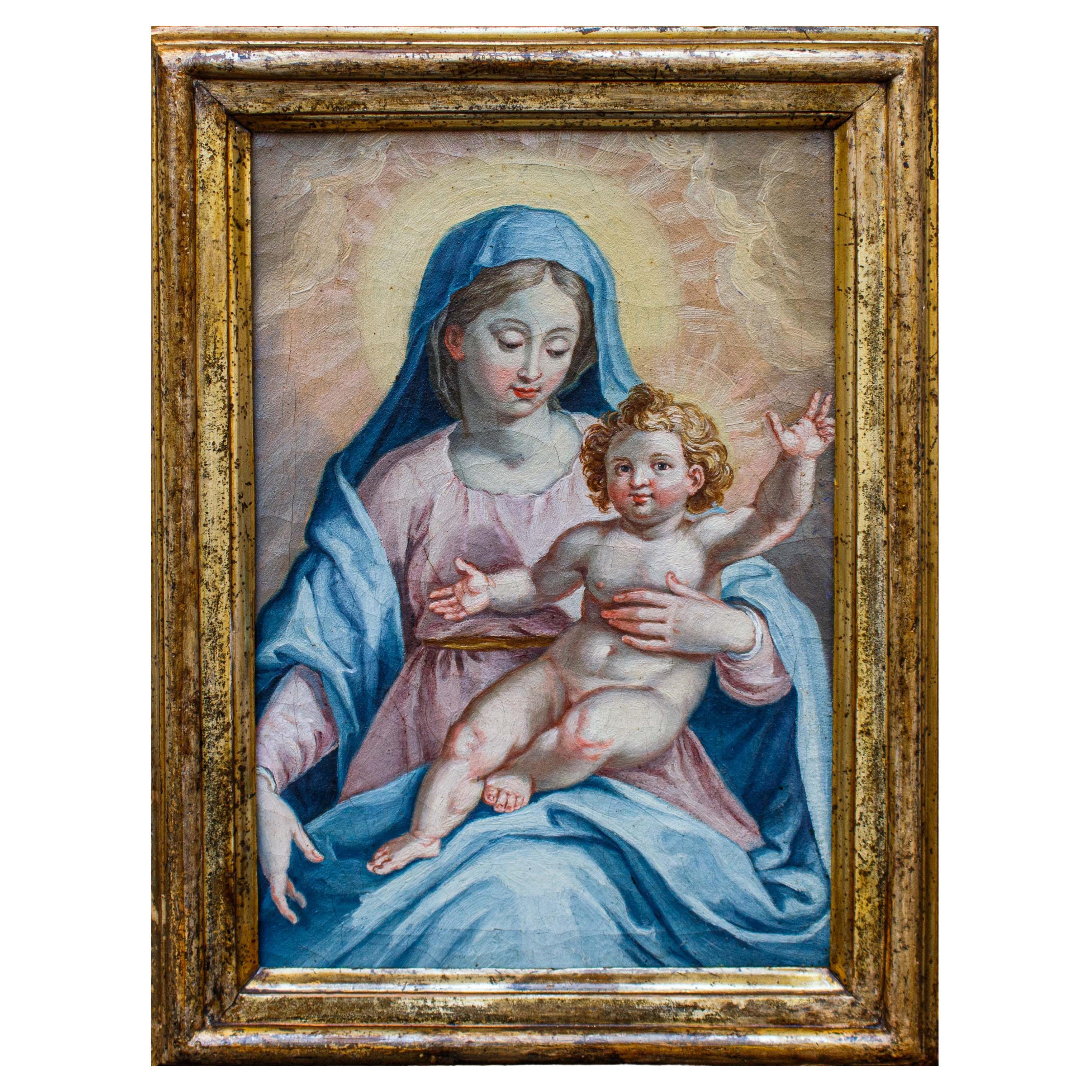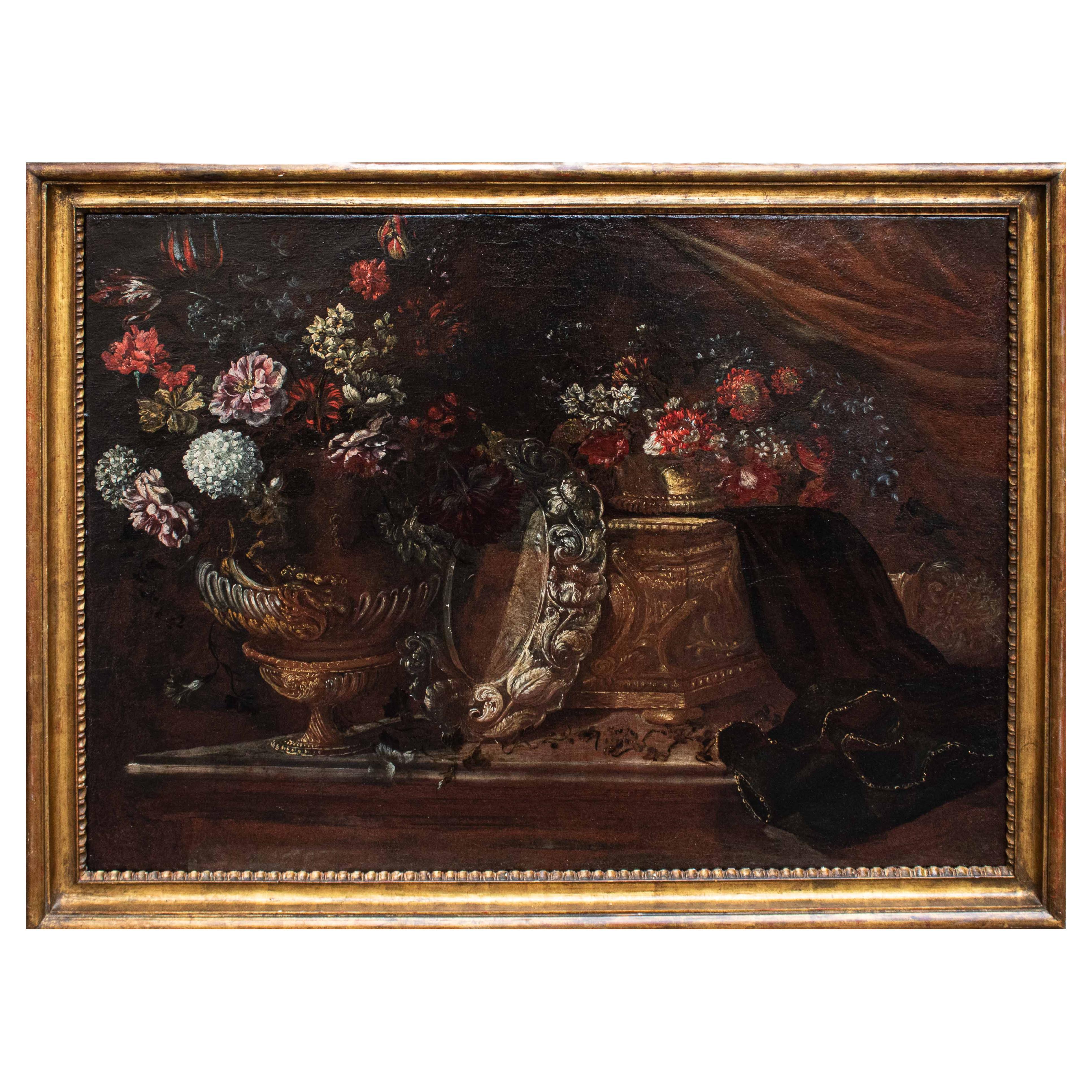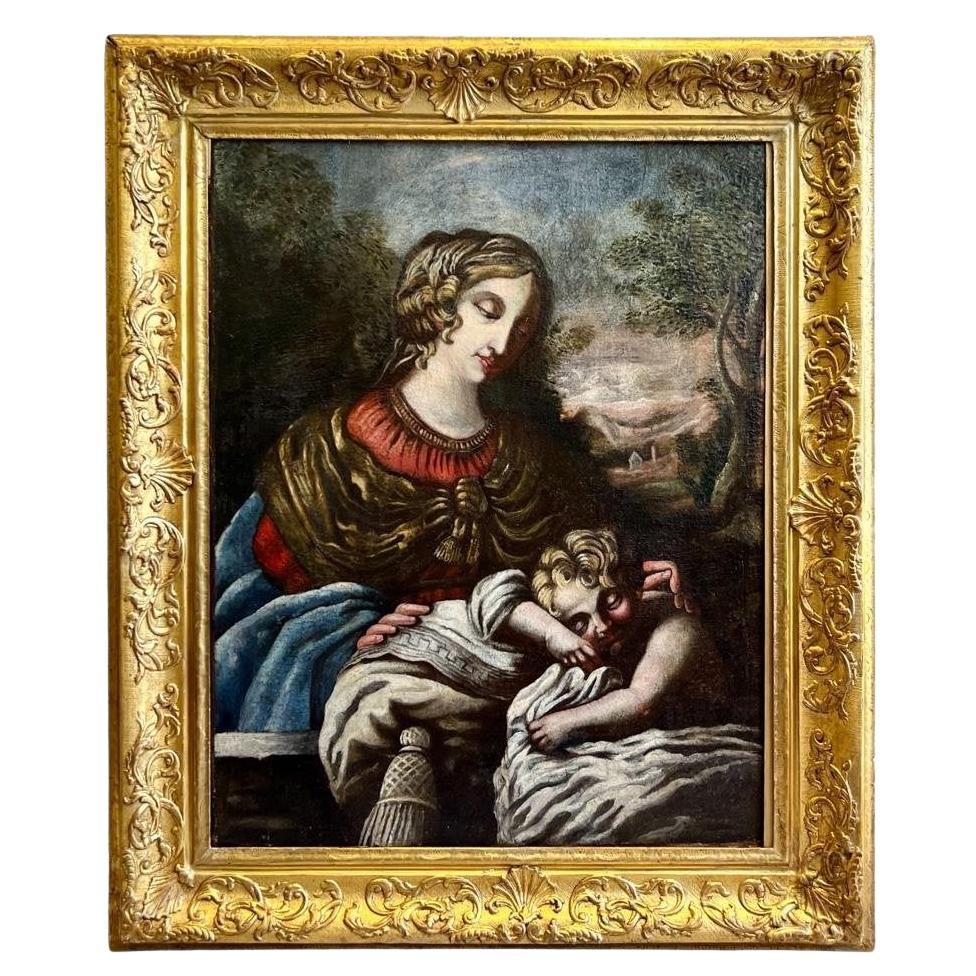Items Similar to Early 17th Century Roman School Praying Madonna Painting Oil on Canvas
Want more images or videos?
Request additional images or videos from the seller
1 of 9
Early 17th Century Roman School Praying Madonna Painting Oil on Canvas
About the Item
Roman school, late 16th-early 17th century Praying Madonna
Oil on canvas, 81 x 69 cm
Frame 83 x 95.5 cm
A divine whiteness reverberates with vibrant luster on the maphorion of the present Virgin. The palpable iridescence that structures the thin rosaceous garment, woven with the same fresh light, produces a slight rustle when she takes her hands off. The Madonna in fact takes a prayerful pose, opening her palms to underline her fervent ecstatic intention; the white neck is rendered with perishable fullness of pigments, like the hands, perfectly alive, and the very shiny eyes. With fine shrewdness the artist of the present styles the Virgin's hair with thin white ribbons, exacerbating the purity. An evocative light falls gently on the bust, a materialized sign of divine glory.
The present can be traced back to the late Mannerist climate that prevailed in the capital after the emanation of the Tridentine council (1545-1563). The late Mannerist licenses that can still be seen there, such as the intense lyricism in the stylistic code adopted by the artist, are innervated in the new basic catechetical intent, which at the end of the century produced a certain figurative rigorism. The present, however, still responds to that extraordinary Roman dynamism that raised the capital to a bulwark for the entire mannerist lesson, matched only by a second artistic center, the Florentine one. The engaging carriage of the Virgin reflects the contemporary examples of Giuseppe Valeriano (1542-1596), a Jesuit painter, returning in the Marriage of the Virgin of the Roman Church of Jesus, as well as in the Madonna of Sorrows in the Recanati Altarpiece, equal ardor. But it is in the Assumption of the Virgin painted in four hands with Scipione Pulzone (1540 / 2-1584) that the present reveals the greatest assonance. Valeriano attended to the decoration of the Chapel of the Madonna della Strada within the Church of the Gesù, together with the Pulzone, with seven paintings relating to the Stories of the Virgin; the Presentation in the Temple, in particular, offers the same brilliance of clothing that also belongs to the present, of very lucid liquefaction on the outstretched arms of the priest. The gesture of the Virgin, of explicit immediacy, is also equal to that of the agitated Virgin foretold by Marcello Venusti (1512 / 5-1579) of the Rijksmuseum in Amsterdam. It is still up to a work by Scipione Pulzone, the Immaculate Conception for the Church of S. Francesco di Ronciglione (today Museum of Palazzo Doebbing) the interweaving reference, with the painting in question, to the full face of the Madonna. The significant plurality of addresses that occurred in the papal area at the end of the century, encouraged by the need to spread the cultural program of new brotherhoods and religious orders, also justifies the memory of Federico Barocci (1528-1612), significantly similar to Raffaellino Motta called da Reggio (1550-1578) in colorism. The lively modulations of the chromatic range, here with dominant pink tones, were in fact sought, first of all, by Barocci, champion of the Counter-Reformation age; for Barocci the famous Madonna of the cherries are mentioned, while for Motta the Tobiolo and the angel (Galleria Borghese, Rome), of noble and immediate brilliance like the present Madonna. with the painting in question, for the full face of the Madonna. The significant plurality of addresses that occurred in the papal area at the end of the century, encouraged by the need to spread the cultural program of new brotherhoods and religious orders, also justifies the memory of Federico Barocci (1528-1612), significantly similar to Raffaellino Motta called da Reggio (1550-1578) in colorism. The lively modulations of the chromatic range, here with dominant pink tones, were in fact sought, first of all, by Barocci, champion of the Counter-Reformation age; for Barocci the famous Madonna of the cherries are mentioned, while for Motta the Tobiolo and the angel (Galleria Borghese, Rome), of noble and immediate brilliance like the present Madonna. with the painting in question, for the full face of the Madonna. The significant plurality of addresses that occurred in the papal area at the end of the century, encouraged by the need to spread the cultural program of new brotherhoods and religious orders, also justifies the memory of Federico Barocci (1528-1612), significantly similar to Raffaellino Motta called da Reggio (1550-1578) in colorism. The lively modulations of the chromatic range, here with dominant pink tones, were in fact sought, first of all, by Barocci, champion of the Counter-Reformation age; for Barocci the famous Madonna of the cherries are mentioned, while for Motta the Tobiolo and the angel (Galleria Borghese, Rome), of noble and immediate brilliance like the present Madonna. The significant plurality of addresses that occurred in the papal area at the end of the century, encouraged by the need to spread the cultural program of new brotherhoods and religious orders, also justifies the memory of Federico Barocci (1528-1612), significantly similar to Raffaellino Motta called da Reggio (1550-1578) in colorism. The lively modulations of the chromatic range, here with dominant pink tones, were in fact sought, first of all, by Barocci, champion of the Counter-Reformation age; for Barocci the famous Madonna of the cherries are mentioned, while for Motta the Tobiolo and the angel (Galleria Borghese, Rome), of noble and immediate brilliance like the present Madonna. The significant plurality of addresses that occurred in the papal area at the end of the century, encouraged by the need to spread the cultural program of new brotherhoods and religious orders, also justifies the memory of Federico Barocci (1528-1612), significantly similar to Raffaellino Motta called da Reggio (1550-1578) in colorism. The lively modulations of the chromatic range, here with dominant pink tones, were in fact sought, first of all, by Barocci, champion of the Counter-Reformation age; for Barocci the famous Madonna of the cherries are mentioned, while for Motta the Tobiolo and the angel (Galleria Borghese, Rome), of noble and immediate brilliance like the present Madonna. encouraged by the need to spread the cultural program of new brotherhoods and religious orders, it also justifies the memory of Federico Barocci (1528-1612), significantly similar to Raffaellino Motta called da Reggio (1550-1578) in colorism. The lively modulations of the chromatic range, here with dominant pink tones, were in fact sought, first of all, by Barocci, champion of the Counter-Reformation age; for Barocci the famous Madonna of the cherries are mentioned, while for Motta the Tobiolo and the angel (Galleria Borghese, Rome), of noble and immediate brilliance like the present Madonna. encouraged by the need to spread the cultural program of new brotherhoods and religious orders, it also justifies the memory of Federico Barocci (1528-1612), significantly similar to Raffaellino Motta called da Reggio (1550-1578) in colorism. The lively modulations of the chromatic range, here with dominant pink tones, were in fact sought, first of all, by Barocci, champion of the Counter-Reformation age; for Barocci the famous Madonna of the cherries are mentioned, while for Motta the Tobiolo and the angel (Galleria Borghese, Rome), of noble and immediate brilliance like the present Madonna. here with their dominant pink tones, they were in fact sought, first of all, by Barocci, champion of the Counter-Reformation age; for Barocci the famous Madonna of the cherries are mentioned, while for Motta the Tobiolo and the angel (Galleria Borghese, Rome), of noble and immediate brilliance like the present Madonna. here with their dominant pink tones, they were in fact sought, first of all, by Barocci, champion of the Counter-Reformation age; for Barocci the famous Madonna of the cherries are mentioned, while for Motta the Tobiolo and the angel (Galleria Borghese, Rome), of noble and immediate brilliance like the present Madonna.
- Dimensions:Height: 37.6 in (95.5 cm)Width: 32.68 in (83 cm)Depth: 1.97 in (5 cm)
- Materials and Techniques:
- Place of Origin:
- Period:Early 17th Century
- Date of Manufacture:Early 17th Century
- Condition:Refinished. Wear consistent with age and use. The painting has been cleaned.
- Seller Location:Milan, IT
- Reference Number:1stDibs: LU5918226763332

About the Seller
5.0
Vetted Seller
These experienced sellers undergo a comprehensive evaluation by our team of in-house experts.
Established in 2000
1stDibs seller since 2021
25 sales on 1stDibs
Typical response time: 10 hours
- ShippingRetrieving quote...Ships From: Milan, Italy
- Return PolicyA return for this item may be initiated within 14 days of delivery.
More From This SellerView All
- 17th Century Madonna with Child Painting Oil on Canvas Tuscan SchoolLocated in Milan, IT17th century, Tuscan school Madonna and Child Oil on canvas, 31 x 21 cm With frame, cm 37,5 x 27,5 The pearly incarnations and the thoughtful play of looks between the Virgin, turned to the Son, and Questi, warmly open to the viewer, pour out the present painting with compositional perfection. Virginal fabrics become mottled at the folds, wrapping the Madonna in a thin vitreous mantle. The pastel colors, shining on the pink robe just tightened at the waist by a gold cord, enliven the faces of the divine couple in correspondence of the cheeks, lit by an orange warmth. Even the left hand of the Virgin, composed in perfect classical pose (Botticelli, Madonna with Child, 1467, Musée du Petit Palais, Avignon), is sprinkled with warmth thanks to the immediate touch with Christ. From the nimbus of the Mother a delicate luminous disk is effused, which takes back, in the most distant rays, the colour of the hair of the Son, from the tones of the sun. The Child Jesus is represented intent in a tender gesture of invitation with the right hand, while with the other he offers a universal blessing: with his hand he retracts the index and annular palms, extending the remaining three fingers, symbol of Father, Son and Holy Spirit. The painting welcomes and re-elaborates that typically Tuscan formalism that boasted in the rest of Italy the constant appreciation by the most up-to-date artists and collectors. Arrangement, composition and mixing of colors place the canvas in the middle between the changing mannerist and the sculptural figures of Michelangelo, essential yardstick of comparison in terms of anatomical and expressionistic rendering. In the present, silvery and pinkish powders act as three-dimensional inducers to the Child’s mentioned musculature and to the vivid folds of the clothes, expertly deposited on the lunar whiteness of the skins. While these colours recall the equally brilliantly transparent colours of Pier Francesco Foschi...Category
Antique 17th Century Italian Paintings
MaterialsCanvas
- Oil painting on canvas depicting Still life Roman school of the 17th centuryLocated in Milan, ITRoman School, 17th century Still Life Oil on canvas, 79 x 107 cm Framed, 93 x 121 cm The work under scrutiny, depicting a majestic still life of flowers, is ascribed to the 17th...Category
Antique 17th Century Paintings
MaterialsCanvas
- 17th Century Angelica and Medoro Painted Oil on Canvas Roman SchoolLocated in Milan, ITRoman School, 17th century Angelica and Medoro engrave their names on the bark of a tree Oil on canvas, 65 x 48.5 cm The canvas depicts one of the most famous episodes of O...Category
Antique 17th Century Italian Paintings
MaterialsCanvas
- 17th Century Christ and the Samaritan Oil on Canvas Roman SchoolLocated in Milan, ITRoman school of the 17th century Landscape with bridge - Christ and the Samaritan woman at the well Oil on canvas, cm 42 x 59,5 - With frame, cm 54, 5 x 71 cm The small canvas portrays a broad view of the city surrounded by a bucolic and lush landscape, probably a reinterpretation of the Roman countryside or the Agro. The fulcrum of the canvas is the bridge consisting of several bays beyond which stands a village. In the distance the landscape made of green mountains opens into what looks like a lake crossed by boats. The landscape is animated by the human presence; not only small and fleeting figurines intent on walking along earthy paths but also the representation, in the foreground, of an Gospel episode, that of Christ and the Samaritan woman at the well. The landscape can be clearly traced back to a painter trained on the examples of the great seventeenth-century Roman baroque landscape that sees in the Lunette Aldobrandini by Annibale Carracci but also in Claude Lorrain, Nicolas Poussin and Gaspar Doghet are its greatest achievers. If in the past, therefore, the landscape was considered the scenic background on which to project the representation of divine or human characters, in the seventeenth century it became an autonomous and codified pictorial genre. With Carracci comes the so-called ideal landscape: a mental reconstruction of a peaceful and harmonious nature in which the dream of a perfect communion with man is realized. In the wake of Hannibal, as mentioned, during the seventeenth century the "classic" Roman landscape knows a long and happy season by artists such as Domenichino, and the French Claude Lorrain, Nicolas Poussin and Gaspar Dughet. Lorrain investigates the Roman countryside in all its aspects, studying the variations in the different hours of the day, the seasons or weather conditions, but always nourished by a sense of bucolic Virgilian. With Poussin the approach becomes intellectual elaboration and sophisticated rational construction. From the examples of the great masters, the Roman Baroque season, from the middle of the century, saw the flourishing of several personalities who, with shots, but also important personal reworkings, led to further spread the genre. Among the personalities that can be compared to the work in question we cannot fail to mention Crescenzio Onofri (1634-1714), defined by Salerno as the only true pupil of Dughet, who then spread in Florence the taste of the Baroque landscape influencing Tuscan painters such as Panfi and Peruzzini. His paintings are in various Roman collections; such as, for example, the landscapes from the Sacchetti Collection and today at the Pinacoteca Capitolina. and those in the Almagià collection in Rome, others in the Palazzo di Montecitorio, but the most conspicuous group is in the Galleria Doria. In comparison we can mention the two passages of the National Gallery in London, the landscape with a bridge over the Antiquarian Market but also the design of the National Gallery of Art in Washington. In the work you can also find the influences of the art of Giovanni Francesco Grimaldi...Category
Antique 17th Century Italian Paintings
MaterialsCanvas
- 17th Century Roman Landscape Painting Oil on Canvas by BloemenLocated in Milan, ITWorkshop of Jan Frans van Bloemen (Antwerp, 1622 - Rome, 1749) Lazio landscape Oil on canvas, 48.5 x 64.5 cm The painting, to be considered belonging to the vast production...Category
Antique Late 17th Century Belgian Paintings
MaterialsCanvas
- 17th Century St. John Baptist Florentine School Painting Oil on CanvasLocated in Milan, ITFlorentine school, 17th century St. John Baptist Oil on canvas, diameter cm 20 - with frame diameter 30 In this small round-format canvas, St. J...Category
Antique 17th Century Italian Paintings
MaterialsCanvas
You May Also Like
- 17th Century Oil on Canvas Antique Italian Religious Painting Praying VirginLocated in Vicoforte, PiedmontAntique Italian painting from the late 17th century. Framework oil on canvas depicting a religious subject Praying Madonna of good pictorial quality. Nice size and pleasant impact pa...Category
Antique Late 17th Century Italian Paintings
MaterialsCanvas
- Early 17th Century Tuscan School Oil Painting on Canvas 'Virgin and Child'Located in NICE, FRWe present you this magnificent oil painting on canvas endearingly the Virgin Mary gently caressing the head of Christ Child asleep on His Mother's lap. This artwork has been expertly fit with new canvas and encased in an exquisite gilded wooden frame. It is representative of the Tuscan School...Category
Antique Early 17th Century Italian Baroque Paintings
MaterialsCanvas
- Antique 17th Century Madonna with Child Carlo Maratta 'School' Oil on CanvasLocated in Doha, QAThis magnificent Madonna and Child belongs to an Itlalian (Roman) school of painting and could be a masterpiece of a Carlo Maratta /Maratti (1625-1713) school. Maratta's style of Bar...Category
Antique 17th Century Italian Baroque Paintings
MaterialsCanvas
- 17th Century Oil on Canvas Antique Religious Italian Painting Madonna, 1670Located in Vicoforte, PiedmontAntique Italian painting from the 17th century. Framework oil on canvas depicting a religious subject Madonna of good pictorial quality. Beautifully sized and pleasantly furnished fr...Category
Antique Late 17th Century Italian Paintings
MaterialsCanvas
- 17th Century Italian Madonna /Virgin Mary Oil on CanvasLocated in Doha, QAMagnificent Italian 17th century Portrait of Virgin Mary measures 52 x 68 cm without the frame. The colors are stunning and the painting has never been restored. The Master unfortun...Category
Antique 17th Century Italian Baroque Paintings
MaterialsCanvas
- 17th Century Oil on Canvas Italian Antique Religious Painting Madonna with ChildLocated in Vicoforte, PiedmontGreat Italian painting from the second half of the 17th century. Work oil on canvas depicting a religious subject Madonna with child of good pictorial quality. Painting with a partic...Category
Antique Late 17th Century Italian Paintings
MaterialsCanvas
Recently Viewed
View AllMore Ways To Browse
Late 16th Century Paintings
Italian School Oil Painting 17th
17th Century Religious Paintings
Antique Program
Ribbon Wall Light
Virgin Paint Oil On Canvas
Counter Schools
17th Century Jesus
Religious Oil Painting 17th Century
Angel Bust
Jesus Religious Paintings
Roman Capital
Religious Angel Paintings
Mannerist Style
Florentine School
16th Century Angel
Angel Painting 17th Century
16th Century Religious Painting





